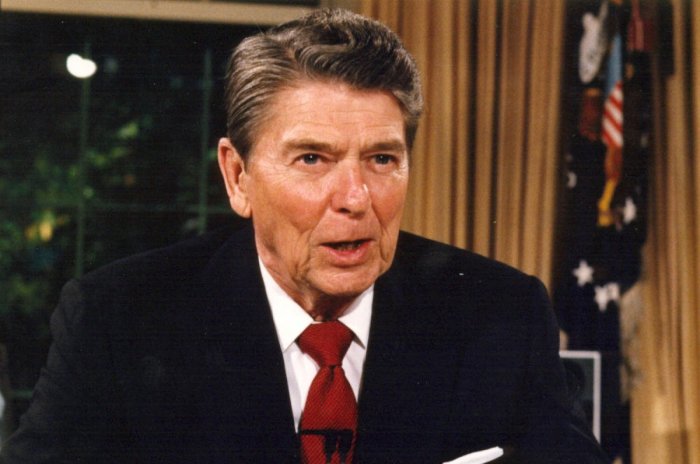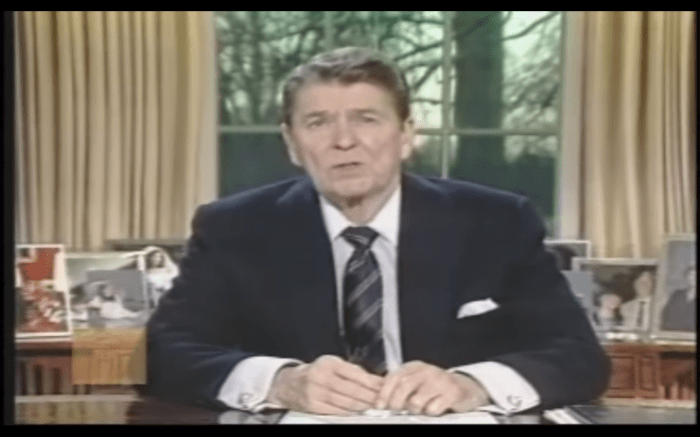Ronald reagan space shuttle challenger speech rhetorical analysis – Ronald Reagan’s Space Shuttle Challenger speech, delivered in the aftermath of the tragic disaster, stands as a testament to the power of rhetoric in times of national crisis. This analysis examines the rhetorical devices, emotional appeals, structure, language, and historical context of Reagan’s speech, exploring how they contribute to its enduring impact.
In the wake of the Challenger explosion, Reagan’s speech sought to provide solace, inspiration, and a sense of national unity. Through the skillful use of rhetorical devices, emotional appeals, and a carefully crafted structure, Reagan’s speech effectively conveyed his message of resilience and hope, leaving a lasting impression on the American people.
1. Introduction: Ronald Reagan Space Shuttle Challenger Speech Rhetorical Analysis
The Ronald Reagan space shuttle Challenger speech, delivered on January 28, 1986, was a powerful and moving address that sought to comfort and inspire a nation in the wake of the tragic loss of the Challenger crew. This rhetorical analysis aims to examine the various rhetorical devices, emotional appeals, and structural elements employed by Reagan to convey his message effectively.
2. Rhetorical Devices
Reagan skillfully employed a range of rhetorical devices to enhance the impact of his speech. Metaphors, such as comparing the Challenger crew to “shooting stars” and “the crew of the starship Enterprise,” evoked a sense of awe and wonder while also conveying the tragic nature of their loss.
Similes, like describing the Challenger’s ascent as “like a bright arrow shot into the heavens,” created vivid imagery and made the event more relatable to the audience.
Personification, as seen in the line “the shuttle Challenger was a dream that soared to the heavens,” attributed human qualities to the shuttle, eliciting empathy and connecting the audience to the loss.
3. Emotional Appeals

Reagan effectively used emotional appeals to connect with his audience and evoke a sense of shared grief and hope. Pathos-based language, such as “we will never forget them” and “their legacy will never die,” resonated with the audience’s emotions.
Imagery, like describing the Challenger crew as “shining stars” and “symbols of our nation’s finest,” created a powerful emotional impact, making the audience feel a personal connection to the tragedy.
4. Structure and Organization

The speech followed a clear and effective structure. The introduction established the context and set the tone for the speech. The body of the speech focused on the crew, their mission, and the impact of their loss.
Reagan used transitions effectively to guide the audience through the speech, creating a sense of coherence and flow. The conclusion provided a sense of closure, offering words of hope and inspiration.
5. Language and Style
Reagan’s use of language and style contributed significantly to the speech’s effectiveness. His diction was precise and evocative, choosing words like “destiny” and “legacy” to convey the significance of the Challenger mission.
The syntax, characterized by short sentences and parallel structures, created a sense of rhythm and urgency, keeping the audience engaged. The tone of the speech was somber and respectful, reflecting the gravity of the occasion.
6. Historical Context

The Challenger disaster occurred against the backdrop of the Cold War and the intense competition between the United States and the Soviet Union in space exploration. This context influenced the speech’s content and delivery, as Reagan sought to convey both a sense of national pride and a commitment to the pursuit of scientific advancement.
7. Audience and Purpose
The intended audience of the speech was the American public, who were deeply affected by the Challenger tragedy. Reagan’s purpose was to offer comfort and inspiration, to honor the crew, and to reaffirm the nation’s commitment to space exploration.
General Inquiries
What was the main purpose of Reagan’s Space Shuttle Challenger speech?
Reagan’s speech aimed to provide solace, inspiration, and a sense of national unity in the wake of the Challenger disaster.
How did Reagan use rhetorical devices to enhance the effectiveness of his speech?
Reagan employed various rhetorical devices, such as metaphors, similes, and personification, to create vivid imagery, evoke emotions, and connect with his audience.
What were some of the key emotional appeals used by Reagan in his speech?
Reagan used emotional appeals, including pathos-based language and imagery, to convey empathy, inspire hope, and foster a sense of shared loss and resilience.